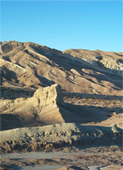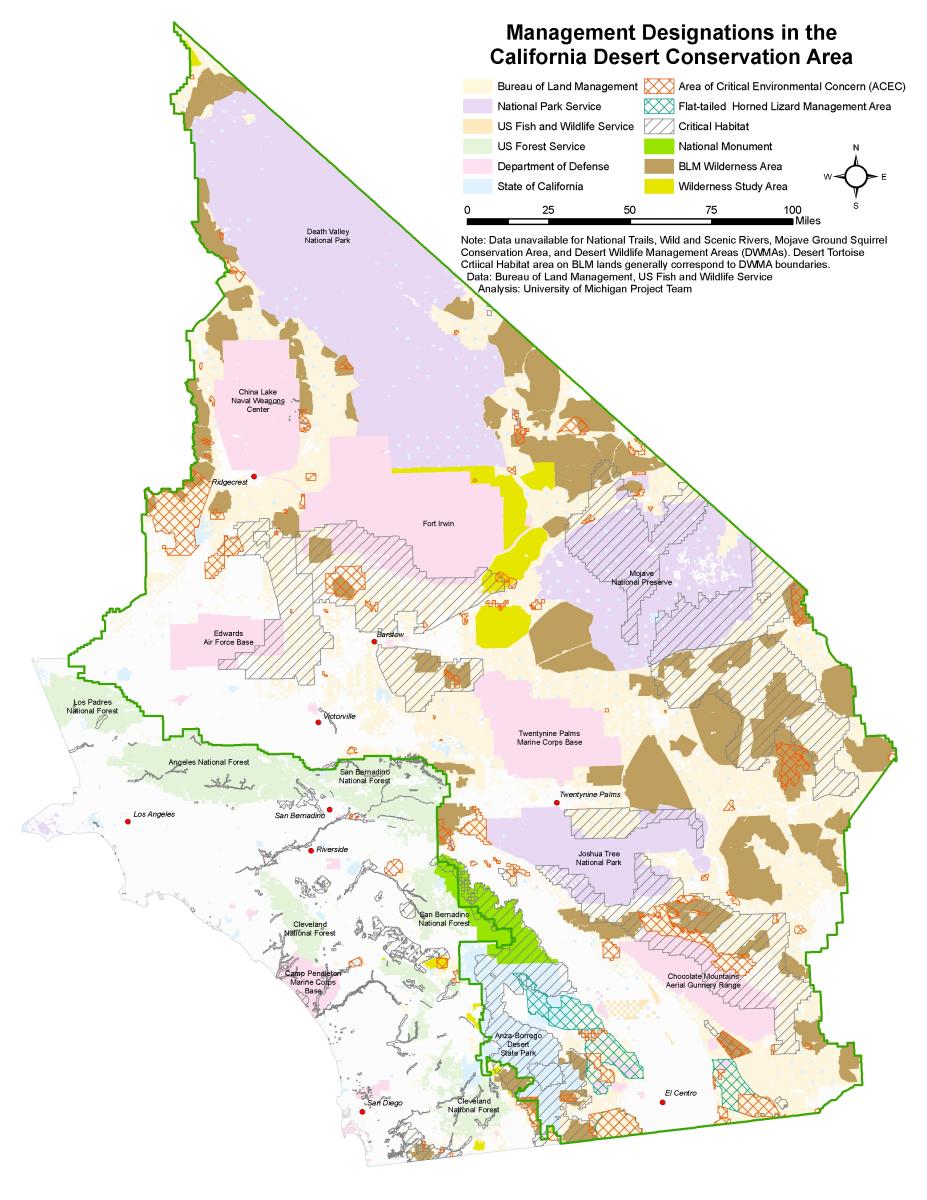
Rainbow Basin
Rainbow Basin is a BLM-managed National Natural Landmark located approximately eight miles north of Barstow. The basin is notable for its rock formations, Miocene-era fossil beds, and the Calico Early Man Site.
BLM Management Areas and Other Designations
On BLM lands within the CDCA, many special management areas and other designations have been established through statue, regulation, and management plan amendments (Map 1). These include Wilderness Areas, Wilderness Study Areas (WSA), Wild and Scenic Rivers (WSR), Areas of Critical Environmental Concern (ACECs), Desert Wildlife Management Areas (DWMAs), critical habitat, Long- term Visitor Areas (LTVAs), and designated routes and areas for off-highway vehicle (OHV) use, among others. Many of these areas prohibit or limit development and are discussed in more detail below.
Wilderness Areas, as set forth by the Wilderness Act, prohibit commercial enterprise, permanent roads and, except as necessary to administer the areas, temporary roads, use of motor vehicles and other forms of mechanized transport, and structures and installations.1 While wilderness areas are not compatible with solar development, indirect impacts from the development of solar facilities on the Federal Reserved Water Rights, air quality protected under the Clean Air Act and additional State standards, and visual resources of wilderness areas will need to be analyzed in a facility's EIS.2
Wilderness Study Areas (WSA) are areas "under study" by Congress as potential wilderness, and, until Congress designates them wilderness or releases them from study, are managed in a manner that does not impair the suitability of such areas to be designated wilderness.3 Current WSAs are therefore excluded from solar development unless released by Congress. Similar considerations for wilderness areas apply to WSAs.
Wild and Scenic Rivers (WSR) are whole rivers or segments of rivers that “possess outstanding remarkable scenic, recreational, geologic, fish and wildlife, historic, cultural or other similar values” and are designated to be “preserved in free-flowing condition” and “protected for the benefit and enjoyment of present and future generations.”4 There are two WSRs in the CDCA administered by the BLM, the Amargosa River (26.3 miles) and Cottonwood Creek (4.1 miles).5
National Monuments, as defined in the Antiquities Act, are “historic landmarks, historic and prehistoric structures, and other objects of historic or scientific interest.”6 They can be established either by Executive Order or by an Act of Congress, and are withdrawn from development. Santa Rosa and San Jacinto Mountains National Monument is the only National Monument in the CDCA.
National Trails are designated to allow for travel close to original trails or routes of historical significance, outdoor recreation uses through nationally significant scenic, historic, natural, or cultural areas, or outdoor recreation uses near urban areas.7 The BLM manages three such trails in the CDCA: the Pacific Crest National Scenic Trail, Juan Bautista de Anza National Historic Trail, and the Old Spanish National Historic Trail.
Areas of Critical Environmental Concern (ACEC) are defined in FLPMA as areas "within the public lands where special management attention is required to protect and prevent irreparable damage to important historical, cultural, or scenic values, fish and wildlife resources, or other natural systems or processes, or to protect life and safety from natural hazards."8 ACECs have special site-specific management prescriptions in order to protect the specific natural or cultural resource for which the ACEC was designated. Development on ACECs may be allowed if such development does not impact the resource for which the ACEC was designated.9
Desert Wildlife Management Areas (DWMA) have been established to protect high quality habitat for the threatened desert tortoise.10 Most DWMAs overlap with critical habitat for the desert tortoise. Individual DWMAs have a one percent surface disturbance limit to protect the desert tortoise.11
Critical habitat areas, as designated under the Endangered Species Act, are protected from "destruction" or "adverse modification" of the habitat.12 In many areas, critical habitat areas overlap with DWMAs. While they may not statutorily prohibit solar development, the amount of disturbance created by a solar facility essentially excludes critical habitat from development.
Special Management Areas, including the Mohave Ground Squirrel Conservation Area and Flat-tailed Horned Lizard Management Areas, are designated for the management of specific species that are considered at risk of being listed under the Endangered Species Act (ESA). These areas have special management prescriptions that may limit surface disturbance within the designated area.
Cultural and Historical Resources listed on the National Register of Historic Places, and other such resources not listed on the National Register that would be impacted by a solar facility will be analyzed in the EIS for each facility.
Long Term Visitor Areas (LTVA) are recreation areas where visitors may camp for several months at a time. There are five LTVAs totaling 3,470 acres in the CDCA.13 Solar energy development within LTVAs would prohibit public use of the areas for recreation.
Off-highway Vehicle (OHV) Use Areas and Routes are the primary recreational use of BLM-managed public lands in the desert. Throughout the CDD, there are 500,000 acres of open areas and an additional 6.7 million acres of routes.14 The BLM has indicated that it has steered developers away from OHV recreation areas, and that solar facilities that block OHV access routes should provide alternate access to those routes.15
1 Wilderness Act (P.L. 88-577; 16 U.S.C. 1131-1136)
2 Bureau of Land Management Staff Member 9, Personal Communication, July 30, 2009.
3 U.S. Department of the Interior, Bureau of Land Management and Office of the Solicitor (editors), The Federal Land Policy and Management Act, as amended, 2001 (Washington, DC: U.S. Department of the Interior, Bureau of Land Management Office of Public Affairs).
4 Wild and Scenic Rivers Act (P.L. 90-542; 16 U.S.C. 1271 et seq.)
5 National Wild and Scenic Rivers System, River Mileage Classifications for Components of the National Wild and Scenic Rivers System, 2009, http://www.rivers.gov/publications/rivers-table.pdf.
6 Antiquities Act (P.L. 59-209; 34 Stat. 225; 16 U.S.C. 431-433)
7 National Trails System Act (P.L. 90-543; 16 U.S.C. 1241-1251)
8 U.S. Department of the Interior, Bureau of Land Management and Office of the Solicitor (editors), The Federal Land Policy and Management Act, as amended, 2001 (Washington, DC: U.S. Department of the Interior, Bureau of Land Management Office of Public Affairs).
9 Bureau of Land Management Staff Member 7, Personal Communication, July 29, 2009.
10 Bureau of Land Management Staff Member 7, Personal Communication, July 29, 2009.
11 Bureau of Land Management Staff Member 7, Personal Communication, July 29, 2009.
12 US Fish and Wildlife Service, ESA Basics, http://www.fws.gov/Endangered/factsheets/ESA_basics.pdf.
13 Bureau of Land Management Staff Member 13, Personal Communication, March 12, 2010.
14 Bureau of Land Management Staff Member 13, Personal Communication, March 12, 2010.
15 Bureau of Land Management Staff Member 7, Personal Communication, July 29, 2009.

